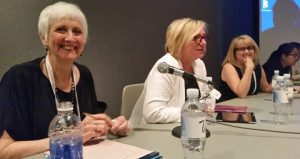
“Everyone’s an author, everyone wants you to buy their book, everyone wants you to put their book in your collection,” said moderator Melissa Rice, head of adult services at Frankfort (Ill.) Public Library District, at “The New Library Imprint: Libraries and Self-Publishing” program at ALA Annual Conference Saturday morning.
With 391,000 self-published titles launched in 2012 alone, it is an exploding scene that libraries may want to be a part of.
“A copier on steroids”
Rivkah Sass, library director of Sacramento (Calif.) Public Library, received a $245,000 grant to purchase an Espresso Book Machine outright, and the library started I Street Press to help local authors turn their words into print. The Espresso Book Machine—which Sass labeled “a Frankenstein monster, a copier on steroids”—has churned out 11,000 books in 168 titles by 137 authors since January 2012. The library assists authors in the basics of formatting and designing covers, assigning ISBN numbers, getting a Library of Congress control number, a copyright, and more. The cost is $6 per book, plus 6 cents per page.
“Everybody has a story to tell, and we wanted to be a part of that process,” she said. While she found there wasn’t a revenue model for the library in training writers and authors, “I believe this is our future,” she said.
A profit-sharing model
At Provincetown (Mass.) Public Library, interim library director Matt Clark went in a very different direction with his library’s publishing model. He spent about $3,500 on software, Apple’s iBooks Author, and set up a system to carefully vet authors. The library would provide support to a select few in editing, formatting, design, social media marketing, getting an ISBN number, and uploading for Apple and Kindle, with a profit-sharing model of 85% of sales to the author and 15% to the library. His goal was to eliminate traditional barriers to publishing and promote digital publishing as a viable outlet.
Some people ruled themselves out by not providing digital manuscripts for review or by offering very dull, unedited manuscripts. “If someone wouldn’t properly edit or format their book, we couldn’t rely on them to help market their work,” Clark said. With the partnership of the Provincetown Public Press, the venture has launched five titles since November 2013.
Academic press
In the academic world, there is also great opportunity for self-publishing, says Cyril Oberlander, director of the Milne Library at SUNY Geneseo. Oberlander, who is soon to be dean of the library at Humboldt State University in Arcata, California, said his library started with a small pilot reprint of a rare book by a Civil War prisoner that was not available digitally. They published open access and on Amazon. The money from Amazon sales helps support the university’s special collections. Oberlander also recommended Library Publishing Toolkit, a free site that helps librarians set up a publishing model. “Free (open access) and fee (Amazon sales) can work together,” Oberlander said.
Other libraries are paying faculty to adopt open textbooks. SUNY Geneseo reviewed 45 proposals, and the college funded 15 for publication. “It saved millions of dollars for students and, at the same time, created an academic press.”
See, hear, and read more about what’s going on at Annual—in real time and after.
Twitter: @alaannual and #alaac14
Facebook: https://www.facebook.com/events/489205011101981/
YouTube: http://www.youtube.com/user/AmLibraryAssociation
Flickr: http://www.flickr.com/groups/alaac14/
Pinterest: http://pinterest.com/alaannual/
Tumblr: http://ala-con.tumblr.com


